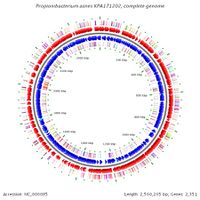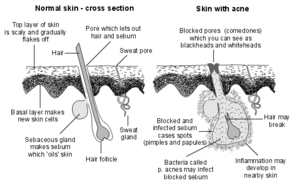Legionella pneumophila
Propionibacterium acnes is a non-sporulating bacilliform (rod-shaped), gram-positive bacterium considered to be the predominant cause of the common inflammatory skin condition acne vulgaris. Although some strains have proven to be aerotolerant, P. acnes is primarily anaerobic, found primarily in the relatively anoxic pilosebaceous unit (a region that contains the hair follicle and sebaceous gland) of adolescent and adult human skin.
Taxonomic Classification
Higher Order Taxa:
Bacteria; Actinobacteria; Actinobacteridae; Actinomycetales; Propionibacterineae; Propionibacteriaceae; Propionibacterium
Alternative Nomenclature:
- Corynebacterium acnes
- Bacillus acnes
- Corynebacterium acnes (Gilchrist 1900 and Eberson 1918)
- Bacillus acnes (Gilchrist 1900)
Genomic Structure

P. acnes' genome consists of a single 2.56026 Mbp circular plasmid containing 2351 genes coding for approximately 2297 known proteins products. P. acnes has a G-C content of 60%.
Cell Structure and Metabolism
Ecology
Pathology
Applications to Biotechnology
Current Research
References
Allison, Clive et al. Dissimilatory Nitrate Reduction by Propionibacterium acnes. Applied and Environmental Microbiology. 1989. Vol. 55 (11): 2899-2903.
Brüggemann, Holger et al. The Complete Genome Sequence of Propionibacterium Acnes, a Commensal of Human Skin. Science. 2005. 305: p. 671-672.
Farrar, Mark D. et al. Genome Sequence and Analysis of a Propionibacterium acnes Bacteriophage, Journal of Bacteriology.2007. Vol. 189 (11) p. 4161–4167.
Higaki, Shuichi et al. Propionibacterium acnes Biotypes and Susceptibility to Minocycline and Keigai-rengyo-to. International Journal of Dermatology. 2004. 43: p. 103–107.
Ingham, Eileen The Immunology of Propionibacterium acnes and Acne. Current Opinion in Infectious Diseases. 1999. Vol. 12(3): p. 191-197.
Liavonchanka, Alena et al. Structure and Mechanism of the Propionibacterium acnes Polyunsaturated Fatty Acid Isomerase. PNAS. 2006. Vol. 103 (8): p. 2581.
Moore, W.E.C. et al. Validity of Propionibacterium acnes (Gilchrist) Douglas and Gunter Comb. Nov. Journal of Bacteriology. 1962. p. 870-874.
Oprica, Cristina et al. Clinical and Microbiological Comparisons of Isotretinoin vs. Tetracycline in Acne Vulgaris. Acta Derm Venereol. 2007. Vol. 87: p. 246–254.
Rosenberg, E. William Bacteriology of Acne. Annual Reviews. 1969. Vol. 20: p. 201-206.
This page was created by Christopher B. Smith under the supervision of Professors Rachel Larson and Kit Pogliano at the University of California, San Diego.

